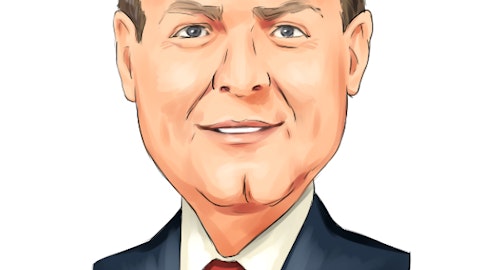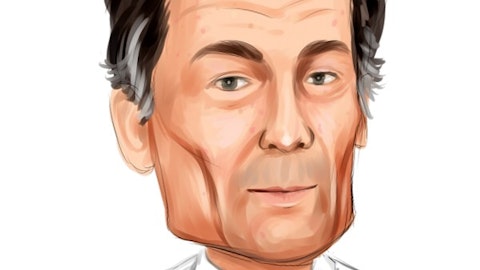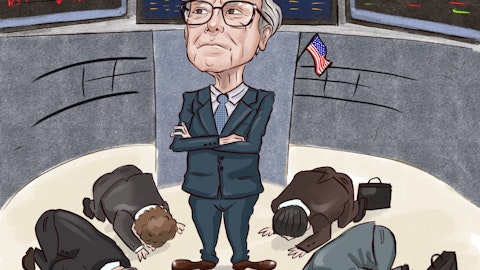Operator: Our next question comes from line of John Murphy with Bank of America. Your line is now open.
John Murphy: Good morning, guys. I just wanted to follow-up on the volatility and schedules that Rod touched on, I think you guys were getting to a little bit. I mean, even at the beginning of this year in January, it sounds like there’s fits and starts and volatility already. It doesn’t seem like it’s something that’s going to ease anytime soon. How should we think about what the actual cost of that volatility was? I mean, you guys were kind of talking about flow through being depressed at 14% on volume and mix. Maybe it should be closer to 18% is it that four points on flow through kind of the way to think about it or is there a dollar number in the quarter and for FY 2022 you could give us so we can think about how to walk off what something might be more normal?
Jerome Dorlack: Yes, I think that 400 basis points seems a little high to me. I think we’d have to circle back if we’re really going to pinpoint a number for you on that. I would suggest though that we do see volume improving from just a start, start standpoint. I think it depends on where your baseline is that you want to measure that from. But the schedules we’re seeing from our customer are far stronger. There’s far less disruptions that we’ve experienced. I’ll say a year ago, nine months ago. There was a time that we were building to about 70% of what the customer was releasing to us on a regular basis. And I think that number is, much higher now probably above 85%. I mean, if you think about kind of sequentially as we go throughout the year, kind of quarter-over-quarter to put in what we expect from improvement.
It certainly isn’t anything like 400 basis points. When we think about kind of the March as we go forward, we’ve always said it’s you know a 100 from a 100 basis points from volume, a 100 basis points from kind of performance and then 100 basis points of what I call kind of balance in, balance out management of our key programs. So in that, 100 basis points of what I’d call performance is where you’d see some of this premium and inefficiency coming out. And so it’s not 400 to be in that 100 basis points bucket, a subset of it.
John Murphy: Okay all right, that’s helpful. And then just second, I mean, I know this is kind of a morbid a weird question, but it does sound like you’re through the worst of the COVID wave in your plants. We’ve heard that from – other suppliers in the industry. So as we go forward, I mean, obviously there is, economic concerns in China. But as far as the COVID disruption, do you think you’re clear the worst of it at the moment on the reopening?
Doug Del Grosso: I think that would be a bit optimistic, just based on the fact that we’ve just returned from Lunar New Year. All the early indications are positive. We were very concerned whether we were going to get the return to work that we had planned for a worse case. It was far better. The employee center plants appear to be healthy. So there’s some indication that perhaps the virus has kind of burned through if you will, and we’re more dealing with natural immunities. But we’ll never claim to be COVID expert.
John Murphy: Yes.
Doug Del Grosso: And if you look at mutations and could there be another wave. We’ve all seen that it’s pretty unpredictable virus. So we’re taking a lot of precautionary measures talking to the team there. They’re relatively optimistic life seems back to normal. Those are all really encouraging signs. But I think we’re kind of more on the – let’s wait and see how this plays over the coming weeks and months before we get over our skis on it.
John Murphy: Yes, that’s fair statement. Lastly, can you just talk about new business wins and how they’re going sort of versus history and how we should think about the book business building and also just kind of remind us if we’re truly through all the less economic contracts from days ago when we’re actually working into more – sort of large majority of portfolio being more normalized contracts though, new business wins and where we are sort of weighted, sort of average of uneconomic to rework contracts?
Doug Del Grosso: Yes, we’re really – the reworker contracts it’s really kind of building out some of the ugly contracts that we had in place. And there’s a tail on that. It gets smaller as time goes on. With regard to new business wins, we feel very good about where we’re at our new business wins. We’ve been able to push back on commercial issues and support that with really outstanding performance with our customers. And such that we can have thoughtful discussions on where we go and kind of have a reasonable expectation on recoveries and not at the expense of the backlog. With regard to the wins, not all customers are created equal and the ones new business that we want to win with the customers that are near and dear to us.
We’ve been extremely successful with. And again, we clearly will walk away from business that we think financially doesn’t make sense even if it’s replacement business. We’ve done that in the past. We think that’s been the smart move for us. We’ll continue to do that in the future. And then when we look at China, I think what’s difficult to predict when you start to build your backlog is really what the mix of that business is going to look like in the future with all the new entrants. We’re excited about the wins that we have there. But we have to be really thoughtful where we invest our capital with those customers as we think that that will be a pretty dynamic market over the course of the next five, 10 years. But I feel great about where we’re at, new business wins.
I think we’re making the right decisions. We’re not trying to measure success solely on market share. We are really focused on return on invested capital to make sure that the business, we win we will get the recovery from an investment standpoint.
John Murphy: Great. Thank you very much.





